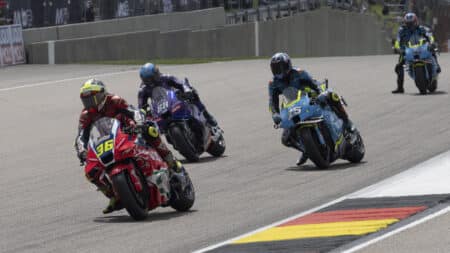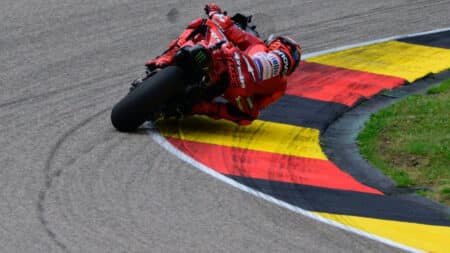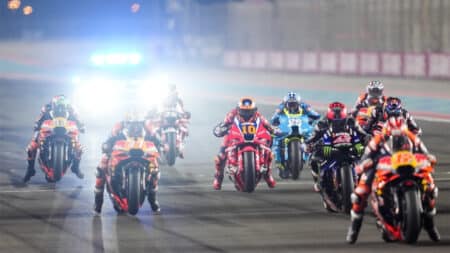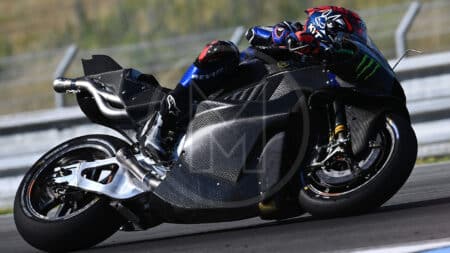What happened at Catalunya, and how and why
Spain celebrates // The Lorenzo saga // Márquez sees positives // Irony of Lorenzo’s move // Rossi and Yamaha’s embarrassment // Petrucci on factory bike // Mass dampers // Latest MotoGP aero regs

Spain celebrates half a century of winning
Spain’s first Grand Prix winner Salvador Cañellas was feted during the Catalunya weekend, 50 years after he became the first Spanish rider to win a world championship race.
Before the event he took part in a photoshoot with Spain’s top MotoGP riders: Marc Márquez, Jorge Lorenzo, Maverick Viñales, Pol and Aleix Espargaró, Dani Pedrosa and Alex Rins. Spain now stands second in the all-time winners’ league, with 588 victories, behind Italy (790) and ahead of Britain (402). It’s worth noting that Italy and Britain scored their first victories in 1949, giving them a two-decade start over Spain.
Cañellas won the 125cc Spanish GP around Barcelona’s Montjuïc Park circuit in May 1968, riding a factory Bultaco. He quit full-time bike racing in 1970, because the death toll was too great. However, he continued to compete in the Montjuïc 24 hours throughout the next decade, winning the race three times. During the 1970s he became a successful rally driver, finishing on the podium in WRC events and taking fourth in the 1977 Monte Carlo Rally. He started his career in the early 1960s, riding a Vespa sidecar in hill-climb events around Barcelona.
The Lorenzo saga: what really happened
There were a few tears shed in the factory Ducati garage on Sunday afternoon as Lorenzo swept to his second consecutive dominant victory, but it wasn’t easy to work out if they were tears of joy or sobs of frustration.
Almost a decade after Ducati lost Casey Stoner to Honda, the Italian brand had finally found a new Stoner, a multiple MotoGP champion who’s mastered the Ducati better than anyone since Stoner, perhaps even better than Andrea Dovizioso, who won six races aboard the Desmosedici last year.
So how come Ducati let Lorenzo slip through its fingers and follow Stoner’s footsteps to Honda? Catalunya was the first time the paddock had convened since the Spaniard dropped his bombshell and was therefore the first chance to talk to the people involved in MotoGP’s biggest contract shock in decades.
Lorenzo told us that he phoned Repsol Honda team manager Alberto Puig a few days after last month’s French GP.
“My first goal was to stay with Ducati,” he said. “Then at Le Mans I realised that maybe Ducati was planning to have another rider, so then we started to plan another way.”
Puig wasn’t surprised to get a phone call from Lorenzo; what did surprise him was that none of the other factories wanted a proven championship winner. Thanks to their failure to get Lorenzo, MotoGP’s five other factories must face a Repsol Honda super team for at least the next two seasons.
Danilo Petrucci was particularly interesting at Catalunya, because he had chances with both Repsol Honda and the factory Ducati team, which already had an option on him for 2019.
“We were talking with Ducati from the beginning of the year and the situation was very up and down,” said the Italian. “At the first tests at Sepang, Lorenzo set a new lap record, so I said to myself, OK, this won’t be a good year for me to get the Ducati factory ride for 2019. Then at Buriram [where Lorenzo was 16th fastest almost a second off the pace] I said, okay, everything is still open. Then we also started following some other options, which is normal.
“At Jerez we discovered there was a possibility with Repsol Honda, so after Le Mans we spoke with Alberto Puig and agreed we could talk again at Mugello. There was a good chance, because Honda Italy and Honda Europe [based in Rome] were very, very happy about this. But then on the Thursday before Mugello, Alberto called us and said, go ahead with your other possibilities, because we have a problem, but he didn’t say what kind of a problem! So I think Lorenzo signed with HRC on the Saturday of Mugello.
“Even for Lorenzo the situation wasn’t so clear for a long time, but I understood at Le Mans that he was already trying to find another way. I had a great race at Le Mans and he did not, so maybe someone from Ducati informed him he was out. I’m lucky that everything happened the way it did, because if Lorenzo had won his first race with Ducati two or three races earlier I would’ve had fewer possibilities for 2019. Now he’s the best rider on the track, I think!”
Despite his recent victories, Lorenzo is living a bittersweet moment.
Petrucci isn’t impressed by MotoGP’s earliest silly season, which has all the major seats filled one-third of the way through the championship.
“The incredible thing is how quickly everyone was signed this year,” Petrucci added. “I remember going to Malaysia for the first test at the end of January and during the stopover in Abu Dhabi I checked the internet and discovered that Maverick Viñales had already signed for next two years.
“I think this is an incredible situation and it’s not fair for some riders, who are already out of their teams after six races. I mean, Bradley Smith and Scott Redding haven’t even had the time to show their potential this year. They have nothing to show, nothing to improve. Mentally, it’s a nasty situation.”
Despite his recent victories, Lorenzo is living a bittersweet moment. “Some weeks ago I was sad to leave a great team because the idea of fighting for the champion with Ducati was amazing,” he said. “It’s sad but the decision is done and the future looks brilliant.”
Márquez sees the positives
The Lorenzo versus Márquez title fight is going to be unforgettable. Most likely, it will be talked about for decades to come, like the Senna/Prost duel at McLaren-Honda. Their battle for supremacy will be fascinating both on the track and in the garage.
Márquez sees the positives of Lorenzo’s arrival, rather than the negatives. After all, fast racers must be optimists; there is no room for pessimists on the podiums. The reigning MotoGP champion believes Lorenzo will help push Honda forward and he can’t wait to analyse his compatriot’s data.
“Jorge will be a strong team-mate and it’s the best thing for Honda to have a strong team,” said Márquez. “When another rider arrives in your garage you can compare your riding style with another style and another way to ride the bike. I’m aggressive and Jorge is so smooth. Cal [Crutchlow] also rides the bike aggressively, so it will be interesting to see how the Honda works with another riding style. When you can see the data of your team-mate it’s easier to see things.”
Fellow HRC rider Crutchlow has similar feelings. “Since Márquez came to MotoGP in 2013 there’s been no top riders coming to Honda,” he said. “It will be good to get more information from someone who’s ridden the Ducati and the Yamaha recently.”

The irony of Lorenzo’s move
Lorenzo isn’t the only top rider that Ducati management has lost in recent years. They lost Stoner in 2010 and Cal Crutchlow in 2014, so might it be that’s there’s too much ego in the company’s upper management to deal with the egos of top riders, which are tricky things to handle.
From now to Valencia, every time Lorenzo wins a race, Ducati CEO Claudio Domenicali won’t know whether to laugh or cry, because he knows that at the very moment he found the best combination of bike and rider he managed to lose it.
Lorenzo thinks he can win this year’s championship. “Now it’s possible, we have the most complete Ducati ever and we have nothing to lose,” he said.
But perhaps the ultimate irony of this defection may fall upon Lorenzo and not upon Ducati and Domenicali. The Ducati already worked better than the Yamaha with Michelins and spec software; now it seems it may work better than the Honda; in which case this Ducati-to-Honda move could turn out to be a bigger loss for Lorenzo.
“Now it’s possible, we have the most complete Ducati ever and we have nothing to lose,”
Márquez was in full pursuit of Lorenzo throughout the Barcelona weekend: he crashed twice and very nearly a third time when he lost the front into the final turn, smoke pouring off the tyre as he jabbed his elbow and knee into the asphalt. That final moment told him all he needed to know: Lorenzo’s limit was beyond his own.
Of course, it’s still way too early to decide which machine is the best, because no one knows how well the Lorenzo/Ducati combination will work at the remaining 12 races. Mugello and Catalunya are similar racetracks, with lots of flowing corners, and at each racetrack the real decider is Michelin’s tyre allocation, which will sometimes suit the RC213V and sometimes the GP18.

Can Rossi save Yamaha’s embarrassment?
If Yamaha doesn’t win at Assen, the Sachsenring or Brno the company will enter its longest victory drought in more than two decades. The last time Yamaha went more than 18 races without victory was way back in the days of 500cc two-strokes, between the 1996 Australian GP, won by Loris Capirossi on a Marlboro Team Rainey YZR500 and the 1998 British GP, won by Simon Crafar on a Red Bull WCM YZR500.
The omens are not good. Rossi may stand second in the title chase, with four podium results from the first seven races, but he has yet to better third-place and at the last three races he has been at least five seconds behind the winner.
“We have two-tenths of a disadvantage against the fastest guys,” said Rossi on Sunday. “I’m happy to get three podiums in a row, but we’ve only finished in a maximum of third, so we are not strong enough to fight. We need to work in different areas to find those two tenths. We need to work on acceleration, because when I follow the Ducati and Honda it looks like their engines and electronics work very well to give a lot of power, without spin. For me, this is the biggest difference.”
Yamaha had a new rear fender at Catalunya, designed to increase wind turbulence and cool the rear tyre. “We’ll try anything,” said one of Rossi’s crew.
Petrucci: factory bike worth a tenth
Petrucci is the biggest benefactor of Lorenzo’s defection and hopes his promotion to Ducati’s 2019 factory team will help achieve his lifetime dream: winning a MotoGP race and challenging for the world title.
“This year my GP19 isn’t 100 per cent a factory bike and although I don’t think there’s a big difference, I missed maybe one-tenth a lap for the win at Le Mans, so I hope to find that tenth in the factory bike and with the factory team,” said Petrucci, who has scored four second-place finishes in MotoGP.
“In the factory team you have more people to help you solve problems, you have more solutions and you get more new parts. It will be another tough season under the lens because my contract is only for one-year, but my target is obviously to remain in that team for some years.”
The Michelin mystery solved
How come the two hottest races of the year have been won by a rider using the softest front and rear tyres available?
At Mugello the track temperature was 51deg C and at Catalunya it was 45deg C. In such conditions, most riders would usually opt for the hardest compounds available, but MotoGP is far from usual these days.
“When it’s very hot you think you need to go harder and harder with the tyres, but it’s not like this anymore,” explained Aprilia’s Aleix Espargaró. “Last year [Johann] Zarco chose the soft rear on many super-hot race days, so the rest of us said, no way will he finish the race, but in fact he finished on the podium!
“I don’t have an explanation, but I think it’s something like this. When the track temperature increases, the grip improves and keeps improving, to a certain level. Then once the track gets hotter than around 40 degrees the grip starts to decrease, so when the track temperature is very high, you once again need the soft compound that you usually only use in cool conditions. The grip is less so you need softer tyres, because the tyre isn’t grippìng the track.”
In fact, most teams are finally getting the hang of the Michelin mystery. Despite the 45deg C track temperature on Sunday at Catalunya, all but four riders chose the soft rear slick, while more than half the grid chose the soft front slick. Alongside Lorenzo on the podium were Valentino Rossi, who also chose soft/soft, and Márquez, who chose hard/hard, because that’s what his riding technique and his machine demand. Could this be a problem for the world champion?
MotoGP is far from usual these days.
Michelin’s motorcycle racing manager Piero Taramasso revealed plenty of interesting information at Catalunya. Riders like Dani Pedrosa and Maverick Viñales are struggling partly because they don’t get enough heat into the tyres during the warm-up lap. Taramasso requests riders to ride the warm-up lap at no less than 95 per cent of full speed to bring the tyres towards peak temperature and grip for the start of the race.
Riders are now allowed to preheat their tyres to 100deg C, instead of the usual 90deg C, to help with this issue. They are also allowed to increase pressure by ten per cent before short, fast runs, to generate more heat and grip. But this wouldn’t be a good idea for a race tyre.
Taramasso also confirmed Crutchlow’s post-Mugello comments about his front tyre overheating while riding in a group, due to the heat coming from rival machines. “We can see it clearly on the data,” he said. “There is less cool air when you are riding in a group, so the tyre pressure increases and you lose grip.”
Riders tested a new-profile Michelin front during Monday’s tests at Catalunya. The tyre has a revised profile to increase edge grip, which should allow riders to brake deeper into corners. But the tyre cannot be raced until 2019. After last year’s midseason change of front-tyre construction flummoxed several riders, teams decided there should be no more midseason changes of tyre profile of construction.

Mass dampers: universal in MotoGP, new to Moto2
All six MotoGP factory teams use mass dampers on their motorcycles, either of the linear (up-and-down) type or the rotational type; the linear units mounted as far away from the centre of mass as possible, the rotational units as close to the centre of mass as possible.
Now mass dampers are creeping into the smaller classes, with the Spanish SAG team using them on its Kalex Moto2 bikes ridden by Isaac Viñales and Jules Danilo.
SAG recently started with its own linear system, which uses a tungsten piston and weighs 280 grams, to damp out tyre chatter (sometimes known as auto-excited vibration) in pursuit of faster race times. SAG started with four ISSR (Inertial Suspension System Racing) mass dampers on its bikes: one mounted on each fork and one on each side of the swingarm.
“But that was a bit of a disaster!” said team-owner Eduardo Perales, who has been running GP teams since 1990. “At first the problem was that the unit damped too much, so the rider couldn’t feel what was going on. Now we only use one damper on the swingarm and we are still trying to understand what works and what doesn’t, which is why we have a 2D sensor attached to the unit. Eventually maybe we could put the damper inside the swingarm. So far the good thing is that the damper seems to reduce rear-shock temperature and we can use a higher tyre pressure and still get a good contact patch, which improves tyre life.”
Some MotoGP suspension technicians aren’t so sure about ISSR. Mass dampers are usually designed to damp out a particular frequency – usually tyre chatter which runs at between 17 and 20Hz – but in damping out that frequency you can run into serious problems when experiencing vibrations at, say, 12 and 24Hz. Also, SAG’s system is attached to the swingarm, part of the motorcycle’s unsprung mass, while most engineers believe mass dampers should be attached to the chassis itself.
Next month SAG will run an ISSR unit on the Au・Teluru MotoUP Racing Team’s Honda CBR1000RR in the Suzuka 8 Hours, with Isaac Viñales, Tetsuta Nagashima and Kosuke Akiyoshi on board
Thanks to Ali Rowland-Rouse for the SAG/ISSR tipoff.

MotoGP aero: everything that’s legal will stay legal
MotoGP’s Grand Prix Commission will meet at Assen to rubber stamp the latest aerodynamics regulations, with few changes expected from the current aero spec. The only big difference is how the bodywork will be assessed: from 2019 MotoGP will use a system not dissimilar to those jigs used in airport departure lounges to check the dimensions of carry-on luggage.
“Everything is already virtually agreed,” said MotoGP technical director Danny Aldridge at Catalunya. “There have been many different versions of the new rules, so we’re just waiting for the final version to approve. The MSMA came back with a box system, which means we will have to construct jigs, within which the different sections of the bodywork must fix. The concept has been decided, so now we just need to define the angles, depth and width of the boxes. But everything that’s legal now will still be legal from next year.
“The only other big thing we will change is banning teams from removing sections from their bodywork, which currently gives them multiple alternatives, which wasn’t the philosophy of the rules we made last year. Each rider will be allowed two different fairings per season, with no subtracting of sections from one race to the next.”










